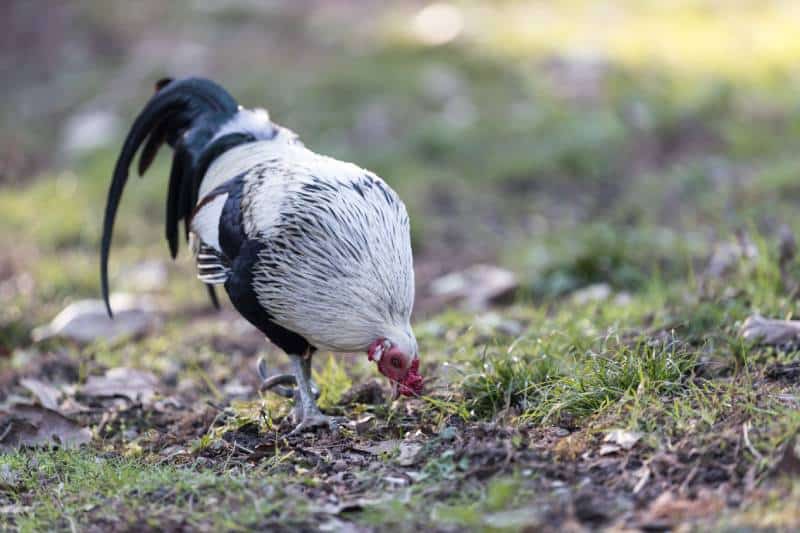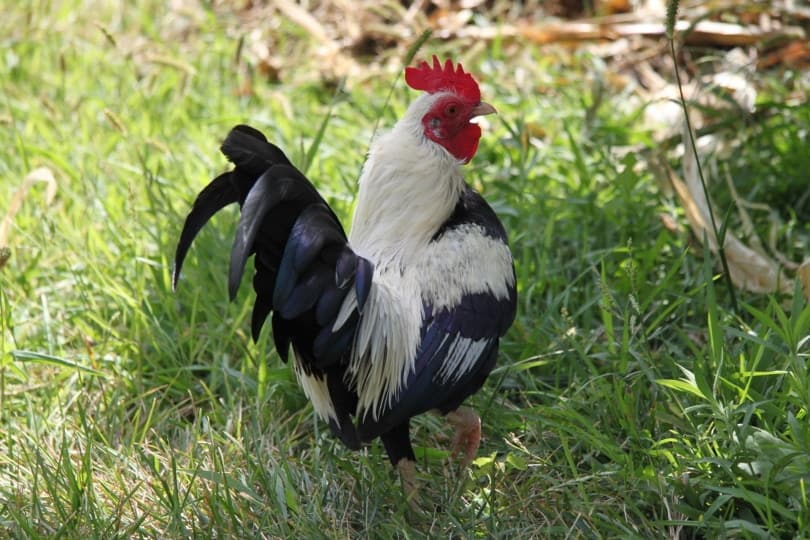Back in the days of cockfighting, the Old English Game Chicken was a popular fighting bird that descended directly from the ancient cockfighting breed, the Pit Game. As the name suggests, the Old English Game Chicken has plenty of years behind its reputation and has not changed much in the last 1,000 years.
Thankfully, the cruel and unnecessary sport of cockfighting is now illegal in most places and the breed serves different purposes to breeders, though they maintain that fierce spirit and strong will. Here we will discuss the ins and out of the Old English Game Chicken and how it has adapted to life outside the ring.

Quick Facts About the Old English Game Chicken
| Breed Name: | Old English Game Chicken |
| Place of Origin: | Great Britain |
| Uses: | Meat, Eggs |
| Rooster (Male) Size: | 1.8 – 2.5 kg |
| Hen (Female) Size: | Up to 1.4 kg |
| Color: | Black, Dun, White, Spangled, Brown, Red, Golden Duckwing, Brassy Back, Black Breasted Red |
| Lifespan: | 15+ years |
| Climate Tolerance: | Cold weather hardy, low heat tolerance |
| Care Level: | Experienced |
| Production: | Meat production, egg-laying |
Old English Game Chicken Origins

The Old English Game or OEG is a direct descendant of the very popular fighting breed known as the Pit Game. It is said that around the 1st century, the Romans brought this game of fowl into England, where the sport of cockfighting grew incredibly popular.
Cockfighting was a low-cost sport that drew in all types of people for participation and spectating. In the early 1800s, public schools in England even welcomed cockfighting as a source of inspiration for children with the birds showing such endurance and strength during battle. The Old English Game chicken was so popular among cockfighters due to their fight-to-the-death mentality.
Cockfighting took a turn when it was banned completely in England, Wales, and the British Overseas Territories thanks to the Cruelty to Animals Act of 1835. This caused the breed to deteriorate in terms of popularity, but some farmers did keep them around for exhibition and crossbreeding.

Old English Game Chicken Characteristics
Small, but mighty, the Old English Game Chicken is naturally aggressive, dominant, noisy, and active. Their confidence and strength are displayed in their upright appearance. Roosters are especially aggressive and territorial and should never be kept together, as they will certainly fight to the death.
Though some individuals may do well with others, it is best to keep this breed apart from other chickens for safety reasons. The breed can be friendly toward their keepers if they are socialized well and kept in ideal conditions.
Old English Game Chickens have superior endurance for extremely cold weather conditions, but they are very sensitive to the heat. The hens are fair egg layers and are usually reliable brooders. If they are not broody, they will typically produce about two white or cream-colored eggs per week. If they are broody, they make wonderful, protective mothers.
Though they mature slowly, the chicks tend to their fighting instincts from a young age. They are known for their longevity, usually living up to 15 years of age or more. The breed does not take well to confinement and will easily become stressed if caged. They require plenty of space to roam and forage and enjoy roosting in trees.

Uses
The Old English Game has thankfully been relieved of its fighting duties due to the banning of the sport, though unfortunately, it does still exist in some areas. Nowadays, they are mainly ornamental birds used for exhibition and cross-breeding and they even make a decent table birds due to their muscular physique.
Appearance & Varieties
Old English Games are known for their incredible body structure and beautiful plumage. This breed has white skin but exhibits a range of stunning color varieties, including black, dun, white, spangled, brown-red, golden duckwing, brassy back, and black-breasted red.
They are heavily muscled with a medium build. They are very compact with broad shoulders, an upright stance, large, curved beaks, and glossy feathers that are tightly bound to their body. Traditionally, the rooster’s combs and wattles were trimmed while they were young, a process known as dubbing. Males and females both have the long, broad tail feathers that are common to game fowl.

Population, Distribution & Habitat
According to The Livestock Conservancy, the Old English Game Chicken is in threatened status. This is largely due to the bans on cockfighting and the fact that these birds aren’t exactly an economical breed for most poultry keepers, thus leaving very little demand.
In terms of habitat, they do quite well in cold weather conditions but have a very poor heat tolerance and are not well suited for hot or humid climates. They are an active and flighty breed that does well in open spaces that allow them to explore and forage.
Are Old English Game Chickens Good for Small-Scale Farming?
This is not an ideal breed for small-scale farming. Most small-scale farms are looking for a docile chicken that is ideal for egg and/or meat production. Though the Old English Game can make great table birds, many other breeds are far better suited for small-scale farms in terms of meat production, egg-laying, and temperament.
In addition, this breed is active and flighty. They will not fare well in small yards and have a distaste for any type of confinement. To remain stress-free, they need room to move, explore and forage and you must keep them away from other birds.

Conclusion
The Old English Game Chickens are long-lived birds with fiery, fierce personalities and the strength and endurance it takes to be a fighter. Though typically friendly to humans, this old breed has gone unchanged since its cockfighting days and is best kept separate from other birds. Even with their impressive looks, they are best suited for experienced keepers that are knowledgeable and prepared to handle them. In the right environment, they can make a welcome addition to the flock.
Featured Image Credit: Public Domain Pictures
